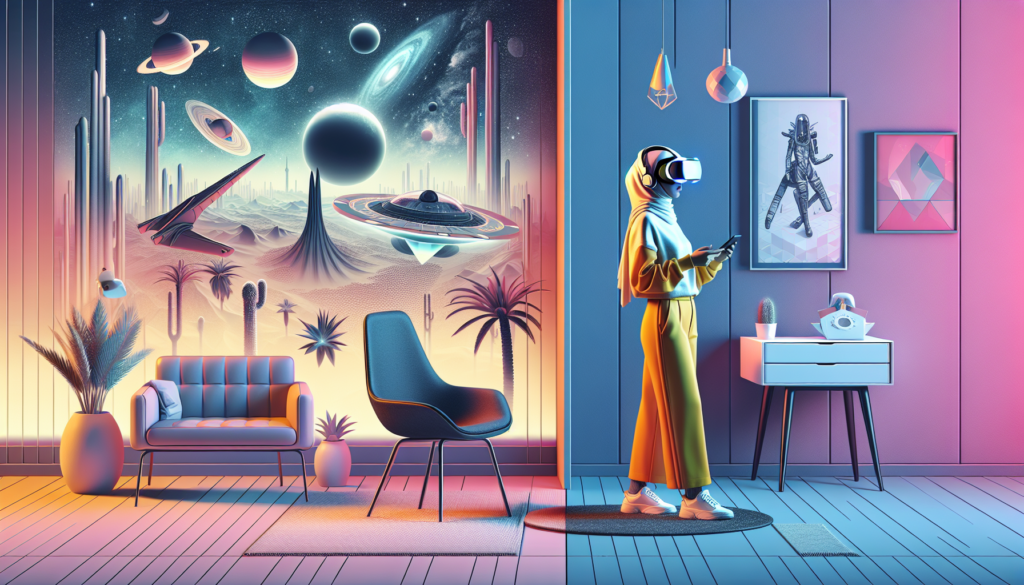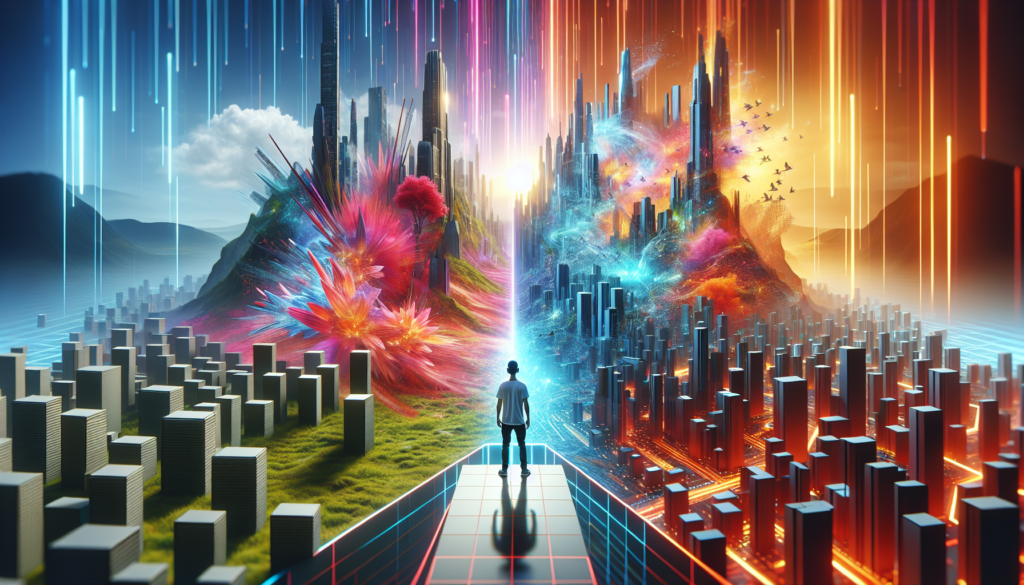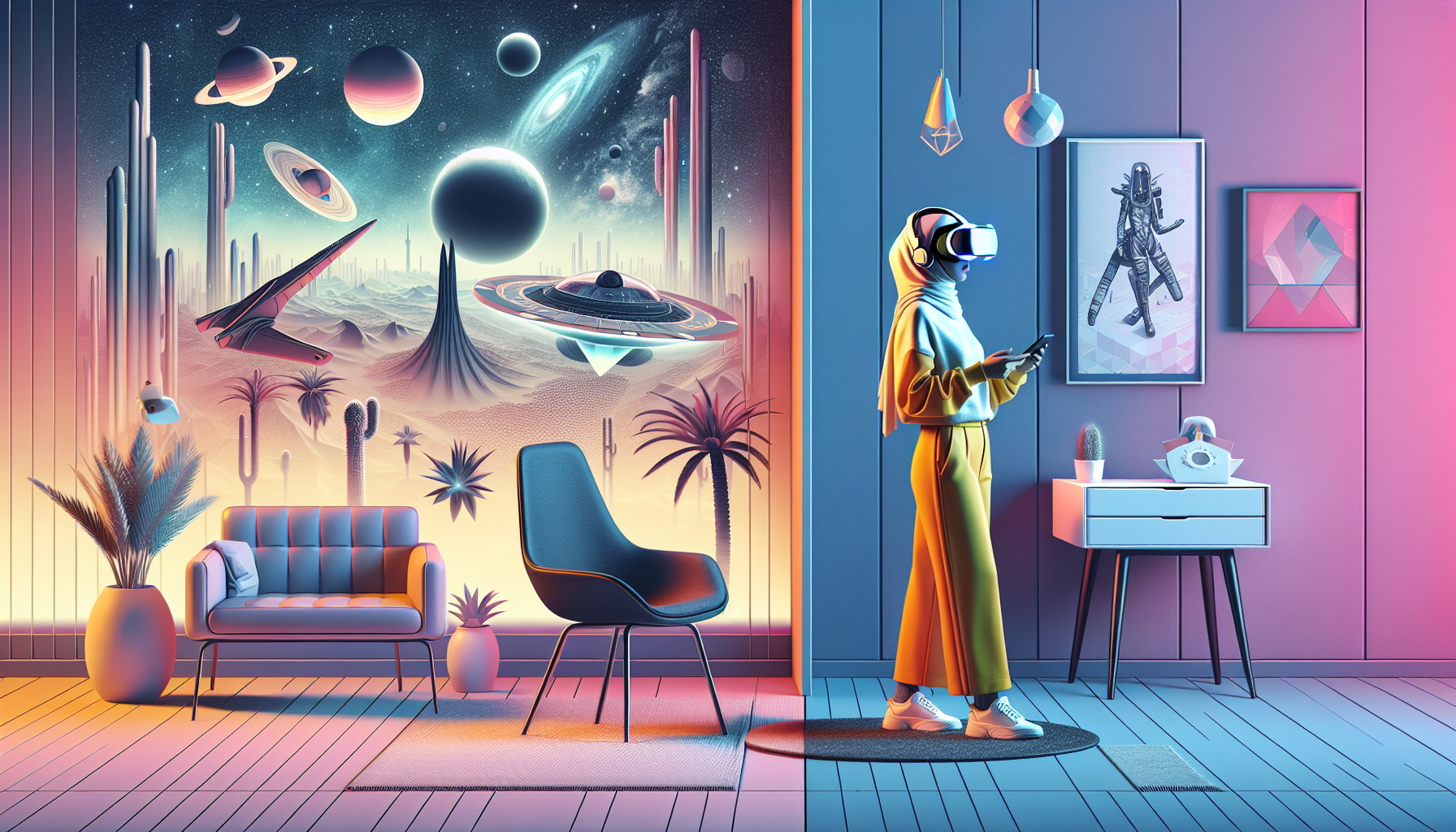Imagine stepping into a world where unicorns roam freely, or exploring ancient ruins without leaving your living room. This is the realm of virtual and augmented reality, commonly referred to as VR and AR. In this exciting article, we will uncover the fascinating concepts behind these immersive technologies and discover how they are revolutionizing the way we experience the world around us. So get ready to transport yourself into a whole new dimension of wonder and possibility!

Overview of Virtual and Augmented Reality
Definition of Virtual Reality
Virtual Reality (VR) refers to a computer-generated environment that simulates real-world experiences. It immerses the user in a digital world, making them feel like they are physically present in that environment. VR typically involves wearing a headset that displays the virtual world and may also include other sensory feedback such as sound or touch.
Definition of Augmented Reality
Augmented Reality (AR) is a technology that overlays virtual elements onto the real world. Unlike VR, AR does not replace the real world entirely but enhances it by adding digital information and graphics. AR can be experienced through various devices such as smartphones, tablets, or smart glasses, allowing users to see both the real world and virtual elements simultaneously.
Difference between Virtual Reality and Augmented Reality
The main difference between VR and AR lies in their level of immersion. VR creates a fully immersive experience by transporting the user to a virtual world, completely replacing their perception of the real world. On the other hand, AR integrates virtual elements into the real world, allowing users to interact with both simultaneously.
In terms of application, VR is often used for gaming and immersive experiences, while AR finds applications in fields like education, healthcare, and navigation.
Applications of Virtual and Augmented Reality
Both VR and AR have a wide range of applications across various industries. They have revolutionized the fields of gaming, education, healthcare, architecture, tourism, marketing, and more. These technologies offer unique and immersive experiences that enhance user engagement and deliver impactful solutions.
Virtual Reality (VR)
Definition of Virtual Reality
Virtual Reality (VR) is a simulated reality that can be similar to or completely different from the real world. It uses interactive computer-generated environments to create a sense of presence and immersion for the user.
History of Virtual Reality
The concept of VR has existed for several decades, with its origins rooted in the 1960s. Early attempts at VR involved the use of head-mounted displays and rudimentary graphics. However, it was not until the 1990s that VR gained more mainstream attention with the introduction of affordable and more advanced hardware.
How Virtual Reality Works
Virtual Reality works by combining visual, auditory, and sometimes haptic feedback to create a realistic and immersive experience. The user wears a VR headset that tracks their head movements, allowing them to look around and explore the virtual environment. In addition to the headset, other devices such as motion controllers or haptic gloves can enhance the user’s interaction with the virtual world.
Types of Virtual Reality
There are several types of VR experiences, ranging from fully immersive to less immersive. Fully immersive VR involves the user wearing a headset that covers their eyes and ears, completely blocking out the real world. Semi-immersive VR provides a partially obstructed view of the real world while still creating a sense of immersion. Non-immersive VR, also known as desktop VR, does not require the use of a headset and can be experienced on a computer screen.
Advantages of Virtual Reality
Virtual Reality offers numerous advantages in various industries. It allows for realistic training simulations, reducing costs and risks associated with physical training. VR can also enable architects and designers to visualize and experience their creations before they are built. In the healthcare sector, VR assists in pain management, therapy, and even surgical procedures. Additionally, VR provides immersive gaming experiences that transport players into virtual worlds.
Disadvantages of Virtual Reality
While VR offers many benefits, there are also some limitations and drawbacks to consider. The cost of VR hardware and software can be a barrier for widespread adoption. VR can also cause discomfort or motion sickness in some users, especially during prolonged use. Additionally, the isolation and disconnect from the real world in fully immersive VR experiences may have negative social implications.
Popular Virtual Reality Devices
Some popular VR devices include the Oculus Rift, HTC Vive, and PlayStation VR. These headsets offer high-quality visuals, precise tracking, and immersive audio, providing users with exciting virtual experiences.
Augmented Reality (AR)
Definition of Augmented Reality
Augmented Reality (AR) overlays digital information onto the real world, enhancing the user’s perception and interaction with their environment. AR technology combines the virtual and the real in real-time, allowing users to see both simultaneously.
History of Augmented Reality
The concept of AR has been around since the 1960s, but it gained more attention in the 1990s with the development of wearable AR systems. Over the years, advancements in mobile devices have made AR more accessible to the general public.
How Augmented Reality Works
AR works by utilizing devices such as smartphones, tablets, or smart glasses, which capture real-world visuals and add overlays of digital content. This is achieved through computer vision and image recognition techniques that track the user’s position and align virtual elements with the real environment.
Types of Augmented Reality
There are different types of AR experiences, including marker-based AR, markerless AR, and projection-based AR. Marker-based AR relies on visual markers, such as QR codes, to trigger digital overlays. Markerless AR uses computer vision algorithms to detect and track objects or surfaces in the real world. Projection-based AR projects virtual images onto real surfaces, creating interactive and dynamic environments.
Advantages of Augmented Reality
Augmented Reality offers numerous benefits in various industries. In education, AR enhances learning by providing interactive and engaging content. For healthcare professionals, AR can aid in surgical planning, allowing them to visualize medical data in real-time. AR also has applications in retail, enabling customers to preview products virtually before making a purchase.
Disadvantages of Augmented Reality
One of the challenges of AR is the need for accurate tracking and alignment of virtual elements with the real world. The technology heavily relies on sensors and cameras, which can be limited in certain environments or lighting conditions. Additionally, the use of AR devices may distract users from their surroundings and pose safety risks.
Popular Augmented Reality Devices
Some popular AR devices include Microsoft HoloLens, Google Glass, and mobile devices with AR capabilities. These devices allow users to experience AR content seamlessly and interact with virtual overlays in the real world.
Virtual Reality vs. Augmented Reality
Definition of Virtual Reality
Virtual Reality (VR) refers to a computer-generated environment that simulates real-world experiences, immersing the user in a digital world.
Definition of Augmented Reality
Augmented Reality (AR) overlays virtual elements onto the real world, enhancing the user’s perception and interaction with their environment.
Comparing Virtual Reality and Augmented Reality
While VR and AR both offer immersive experiences, they differ in their level of immersion and interaction with the real world. VR replaces the real world entirely and isolates the user in a virtual environment, while AR enhances the real world by overlaying virtual elements onto it.
Differences in Immersion and User Experience
In terms of immersion, VR provides a more intense and immersive experience as it completely replaces the user’s perception of reality. On the other hand, AR allows users to stay connected with the real world by augmenting it with virtual elements, creating a mixed reality experience.
Applications of Virtual Reality
Virtual Reality finds applications in gaming, education and training, healthcare, architecture and design, tourism and travel, marketing and advertising, and more. It offers users the opportunity to experience and interact with virtual worlds and provides realistic training simulations and immersive entertainment.
Applications of Augmented Reality
Augmented Reality is used in gaming, education and training, healthcare, manufacturing and engineering, retail and e-commerce, navigation and GPS, and more. AR enhances the real world by providing digital information and graphics, offering users a more interactive and informative experience.

Applications of Virtual Reality
Virtual Reality in Gaming
Virtual Reality has revolutionized the gaming industry by creating immersive and realistic gaming experiences. Players can step into virtual worlds, interact with virtual objects, and engage in physically demanding activities in a virtual environment.
Virtual Reality in Education and Training
VR has made significant contributions to education and training. It enables students to explore historical sites, interact with virtual objects, and participate in simulated experiments, enhancing their learning experience. VR is also used to train professionals in various fields, such as surgery, aviation, and military operations.
Virtual Reality in Healthcare
In healthcare, VR has proven to be a valuable tool. It is used for pain management, distraction during medical procedures, and therapeutic interventions. VR can create calming and immersive environments, reducing anxiety and improving patient outcomes.
Virtual Reality in Architecture and Design
Architects and designers can use VR to visualize and experience their creations before they are constructed. VR allows them to walk through virtual buildings, explore different design options, and make informed decisions. This technology facilitates collaboration and improves the communication of design ideas.
Virtual Reality in Tourism and Travel
VR offers travelers the opportunity to preview destinations and experiences before their actual trips. It allows them to virtually visit landmarks, experience hotel accommodations, and explore tourist attractions. VR enhances the travel planning process and provides a glimpse into what awaits travelers.
Virtual Reality in Marketing and Advertising
VR has become a powerful tool in marketing and advertising campaigns. Brands can create immersive experiences that allow consumers to visualize products, explore virtual showrooms, and engage with branded content. VR enhances the impact of advertisements and creates memorable experiences for customers.
Applications of Augmented Reality
Augmented Reality in Gaming
Similar to VR, AR has made a significant impact on the gaming industry. It enables users to interact with virtual objects superimposed onto the real world, creating engaging and interactive gaming experiences. AR games can be played on smartphones, tablets, or dedicated AR devices.
Augmented Reality in Education and Training
AR enhances education and training by overlaying interactive and educational content onto physical objects or environments. Students can engage with AR-enabled textbooks, which provide additional information, 3D models, or interactive quizzes. AR also has applications in vocational training, helping individuals practice complex tasks or procedures.
Augmented Reality in Healthcare
AR is transforming the healthcare industry by providing real-time information and guidance during medical procedures. Surgeons can use AR overlays to visualize patient data, navigate complex anatomical structures, and precisely plan surgical interventions. AR enhances surgical accuracy and improves patient safety.
Augmented Reality in Manufacturing and Engineering
AR is used in manufacturing and engineering to assist with assembly processes, maintenance tasks, and quality control. With AR-enabled devices, workers can overlay step-by-step instructions onto their workstations, reducing errors and speeding up production. AR enhances worker productivity and efficiency.
Augmented Reality in Retail and E-commerce
AR is revolutionizing the retail industry by offering virtual try-on experiences and enhancing in-store shopping. Customers can use AR apps to visualize how products will look in their homes or try on virtual clothing before making a purchase. AR improves customer engagement and aids in the decision-making process.
Augmented Reality in Navigation and GPS
AR enhances navigation and GPS systems by overlaying digital information, such as route directions or points of interest, onto the real world. Users can navigate their surroundings more easily and get real-time information while remaining aware of their environment. AR improves navigation accuracy and convenience.
Future Trends and Developments
Advancements in Virtual Reality
Virtual Reality technology is continually advancing, with ongoing advancements in display resolution, tracking accuracy, and hardware capabilities. Future developments may include more realistic visuals, improved haptic feedback, and even full-body immersion. The integration of VR with other technologies, such as artificial intelligence and robotics, holds promise for even more transformative experiences.
Advancements in Augmented Reality
Augmented Reality is also experiencing significant advancements, driven by improvements in computer vision, spatial mapping, and wearable devices. Future developments may include more seamless integration of virtual and real elements, enhanced object recognition, and improved spatial tracking. These advancements will enable AR to offer more interactive and intuitive experiences.
Integration of Virtual and Augmented Reality
The integration of VR and AR, often referred to as mixed reality (MR), is an emerging trend. MR seeks to combine the best aspects of both technologies, creating immersive experiences that overlay virtual elements onto the real world. The integration of VR and AR opens up new possibilities for entertainment, education, collaboration, and productivity.
Impact of Virtual and Augmented Reality in Various Industries
Virtual and Augmented Reality have a transformative impact on various industries. In gaming, these technologies redefine immersive gameplay and enable new gaming experiences. In education and training, they revolutionize learning methodologies and provide interactive and engaging content. In healthcare, VR and AR improve patient care, training, and medical interventions.
Challenges and Ethical Considerations in Virtual and Augmented Reality
As VR and AR technologies continue to evolve and become more widespread, it is essential to address the challenges and ethical considerations they present. Issues such as privacy, data security, and the potential for addiction or dependence on virtual experiences need to be carefully addressed. Striking a balance between the benefits and risks of these technologies is crucial.
Conclusion
Virtual Reality and Augmented Reality have transformed the way we perceive and interact with the digital and physical worlds. VR offers fully immersive experiences, transporting users to virtual environments, while AR enhances the real world by overlaying digital elements onto it. Both technologies have found applications across various industries, including gaming, education, healthcare, and manufacturing. Advancements in VR and AR continue to push the boundaries of what is possible, making them increasingly accessible and impactful. As these technologies advance, it is crucial to address the challenges and ethical considerations they raise to ensure their responsible and meaningful use. The future holds exciting possibilities for VR and AR, reshaping how we engage with technology and experience the world around us.
